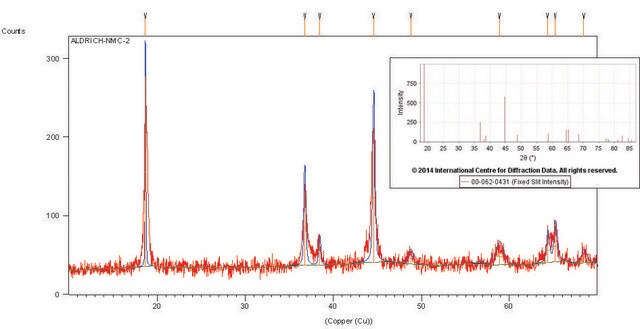Kluczowe dokumenty
442712
Lithium iron(III) oxide
95%
Synonim(y):
Battery_Electrode_Material_Cathode (Materiał_elektrody_katody)
About This Item
Polecane produkty
Próba
95%
Formularz
powder
masa cząsteczkowa
Mw 94.78 g/mol
skład
LiFeO2
charakterystyka ekologicznej alternatywy
Design for Energy Efficiency
Learn more about the Principles of Green Chemistry.
sustainability
Greener Alternative Product
wielkość cząstki
<1 μm
gęstość
1.9 g/mL at 25 °C (lit.)
Zastosowanie
battery manufacturing
kategoria ekologicznej alternatywy
, Enabling
ciąg SMILES
[Li+].[O-][Fe]=O
InChI
1S/Fe.Li.2O/q;+1;;-1
Klucz InChI
JXGGISJJMPYXGJ-UHFFFAOYSA-N
Powiązane kategorie
Opis ogólny
Zastosowanie
produkt powiązany
Hasło ostrzegawcze
Warning
Zwroty wskazujące rodzaj zagrożenia
Zwroty wskazujące środki ostrożności
Klasyfikacja zagrożeń
Acute Tox. 4 Dermal - Acute Tox. 4 Inhalation - Acute Tox. 4 Oral - Lact.
Kod klasy składowania
11 - Combustible Solids
Klasa zagrożenia wodnego (WGK)
WGK 3
Temperatura zapłonu (°F)
Not applicable
Temperatura zapłonu (°C)
Not applicable
Środki ochrony indywidualnej
Eyeshields, Gloves, type P2 (EN 143) respirator cartridges
Wybierz jedną z najnowszych wersji:
Certyfikaty analizy (CoA)
Nie widzisz odpowiedniej wersji?
Jeśli potrzebujesz konkretnej wersji, możesz wyszukać konkretny certyfikat według numeru partii lub serii.
Masz już ten produkt?
Dokumenty związane z niedawno zakupionymi produktami zostały zamieszczone w Bibliotece dokumentów.
Klienci oglądali również te produkty
Produkty
Increasing fuel costs and concerns about greenhouse gas emissions have spurred the growth in sales of hybrid electric vehicles (HEVs) that carry a battery pack to supplement the performance of the internal combustion engine (ICE).
Nanomaterials for Energy Storage in Lithium-ion Battery Applications
Nanomateriały do magazynowania energii w akumulatorach litowo-jonowych
Professor Qiao’s laboratory lays out recent advances in conversion type lithium metal fluoride batteries. This review explores key concepts in developing electrochemically stable microstructures for wide Li-ion insertion channels.
Global Trade Item Number
| SKU | GTIN |
|---|---|
| 442712-100G-A | 4061838147080 |
| 442712-500G-A |
Nasz zespół naukowców ma doświadczenie we wszystkich obszarach badań, w tym w naukach przyrodniczych, materiałoznawstwie, syntezie chemicznej, chromatografii, analityce i wielu innych dziedzinach.
Skontaktuj się z zespołem ds. pomocy technicznej








